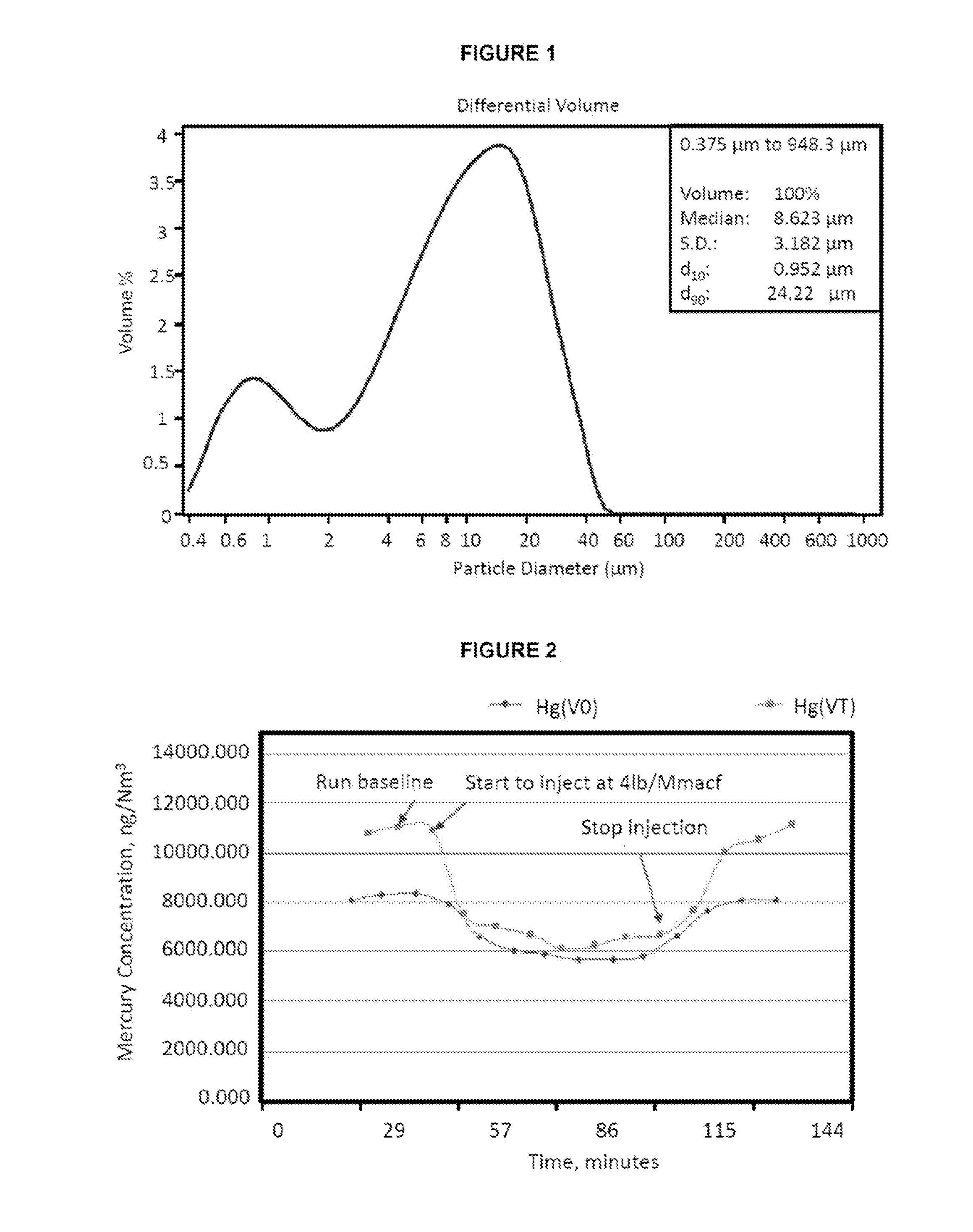Metal contaminant removal compositions and methods for making and using the same
a technology of metal contaminant and composition, applied in the field of metal contaminant removal composition, can solve the problems of high cost, complex and expensive activated carbon production technology, and serious limitations in the safety of their preparation and use, and achieve the effect of high efficiency
- Summary
- Abstract
- Description
- Claims
- Application Information
AI Technical Summary
Benefits of technology
Problems solved by technology
Method used
Image
Examples
example 1
[0126]Various metal sorbent compositions were prepared in which an aqueous suspension or solution of microfine elemental sulfur particles were included. Specifically, samples of different support material were sprayed with an aqueous suspension or solution of active components and dried. Illustrative metal sorbent compositions were prepared as shown in Table 1. The Chabazite support had a particle size distribution of −100 mesh and +325 mesh (MV=100 μm, D50=58 μm). A second Chabazite support has a particle size distribution of −325 mesh (MV=9 μm, D50=6.5 μm). The Diatomaceous Earth (DE) support had a particle size distribution of −325 mesh (MV=16 μm, and D50=10.6 μm). Mean diameter in microns of the “volume distribution” represents the center of gravity of the distribution.
[0127]All samples were prepared by adding 1 kilogram (Kg) of support material to a 5 gallon drum mounted on a cement mixer drive. The drum was equipped with lifters to ensure good product ...
example 2
[0128]Evaluation of metal sorbent compositions was conducted using a lab-scale multiphase flowreactor, 5 ft length×6 inch width column with real flue gas on-line at the Electric Energy Inc. 1,086 MWh utility in Joppa, Ill., U.S.A (Joppa Power Plant). The sorbent addition rate was scaled to equal 4 lbs of sorbent for 1 million actual cubic feet of flue gas, 4 lbs / 1 million acf. The equipment and testing process were according to standard methods (Wu et al., Chemical Engineering Science (2008) 63:782-790). The Joppa Power Plant described above burns Powder River Basin (PRB) coal from Wyoming, which is one of the most difficult coals for removal of mercury. This specific flue gas composition was in the range of 1) Hg˜11,000 ng / m3=8 ppb, Hg(0) / Hg(VT)=80%, 2) SO2=350 ppm, 3) NOx=75 ppm, 4) HCl=5-10, ppm, 5) O2=8% and 6) CO2=11%.
example 3
Metal Capture Performance
[0129]The mercury content of the flue gas was determined before, during and after addition of the metal sorbent composition using an on-line Hg analyzer, semi-continuous emission monitor (Hg-SCEM) (Kellie et al., “Mercury emissions from a 100-MW wall-fired boiler as measured by semi-continuous mercury monitor and Ontario hydro method,”Fuel Progressing Technology (2004) 85:487-499). The efficiency for mercury adsorption was calculated from the Multiphase Flowreactor experiments and was normalized based on the results of a carbon base product of DARC® Hg-LH, a lignite powdered activated carbon from Norit Americas Inc. (Marshall, Tex., USA). The change of the mercury concentration with metal sorbent injection was monitored for each test. See FIG. 2, for data associated with EX1 (Lab-scale Multiphase Flowreactor Test results for metal sorbent composition with 3 Wt-% S8 on Chabazite).
[0130]For these tests the flow tube reactor was heated to 150° C. and the metal ...
PUM
| Property | Measurement | Unit |
|---|---|---|
| particle size | aaaaa | aaaaa |
| particle size | aaaaa | aaaaa |
| melting point | aaaaa | aaaaa |
Abstract
Description
Claims
Application Information
 Login to View More
Login to View More - R&D
- Intellectual Property
- Life Sciences
- Materials
- Tech Scout
- Unparalleled Data Quality
- Higher Quality Content
- 60% Fewer Hallucinations
Browse by: Latest US Patents, China's latest patents, Technical Efficacy Thesaurus, Application Domain, Technology Topic, Popular Technical Reports.
© 2025 PatSnap. All rights reserved.Legal|Privacy policy|Modern Slavery Act Transparency Statement|Sitemap|About US| Contact US: help@patsnap.com

